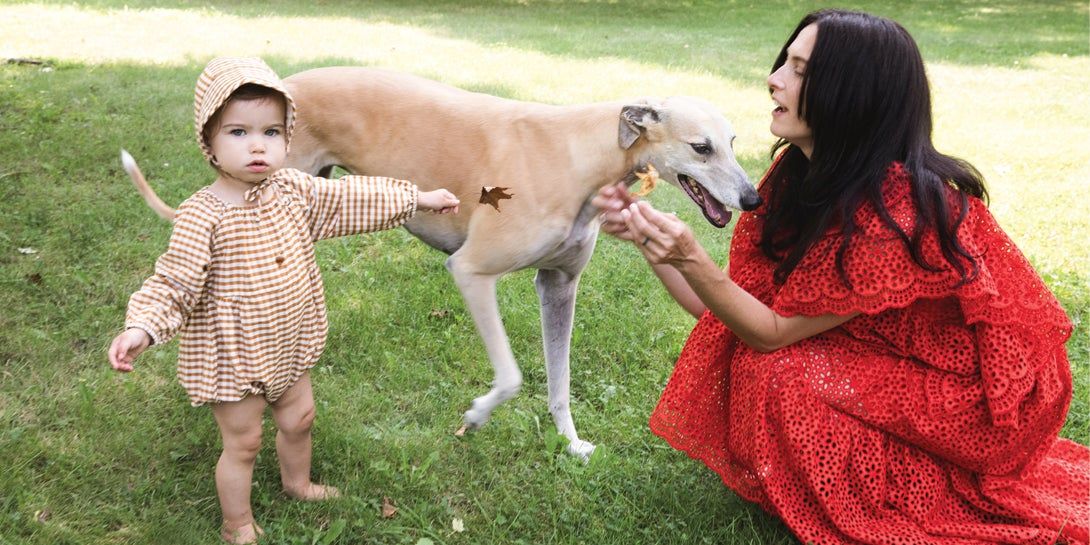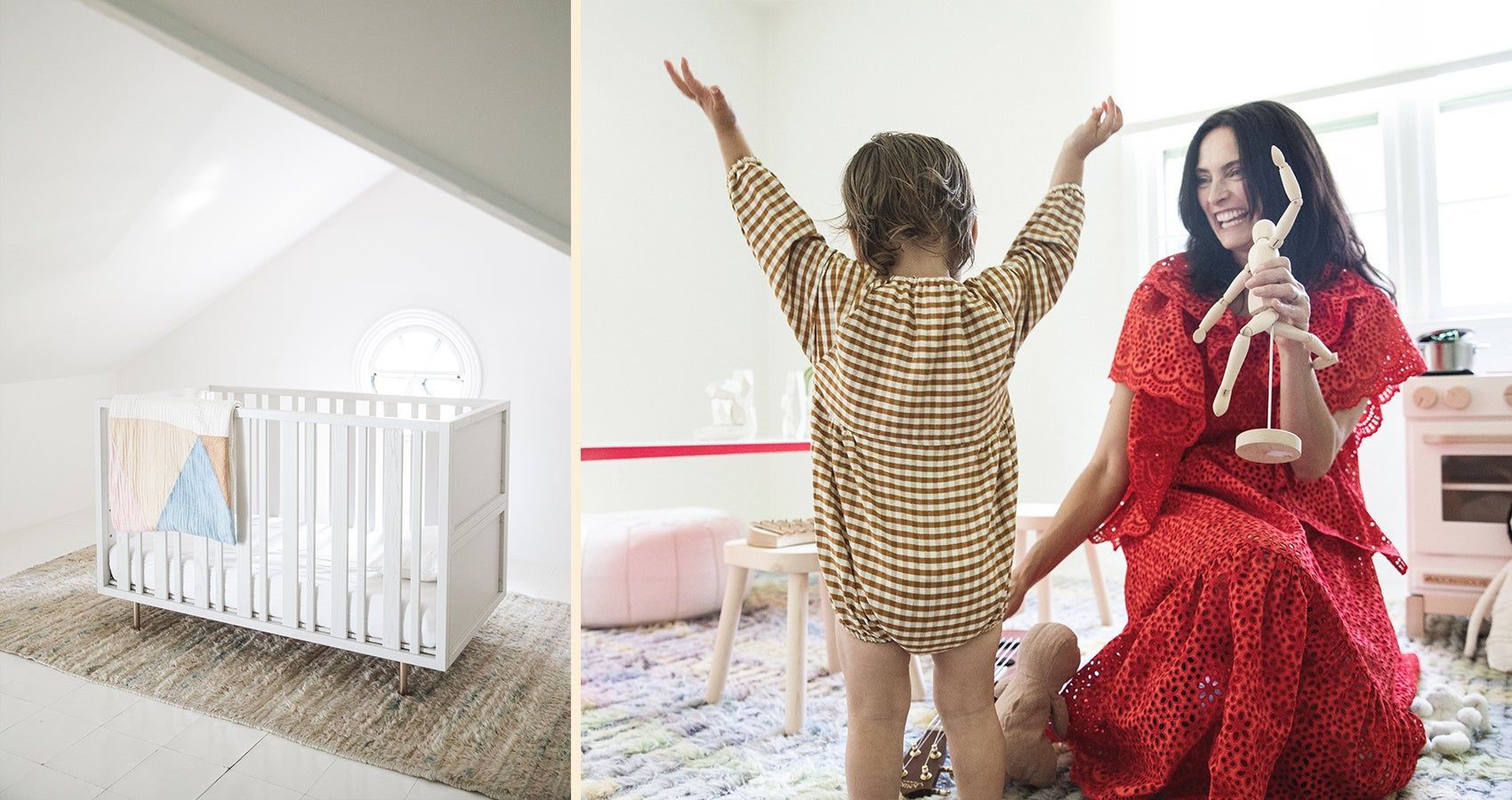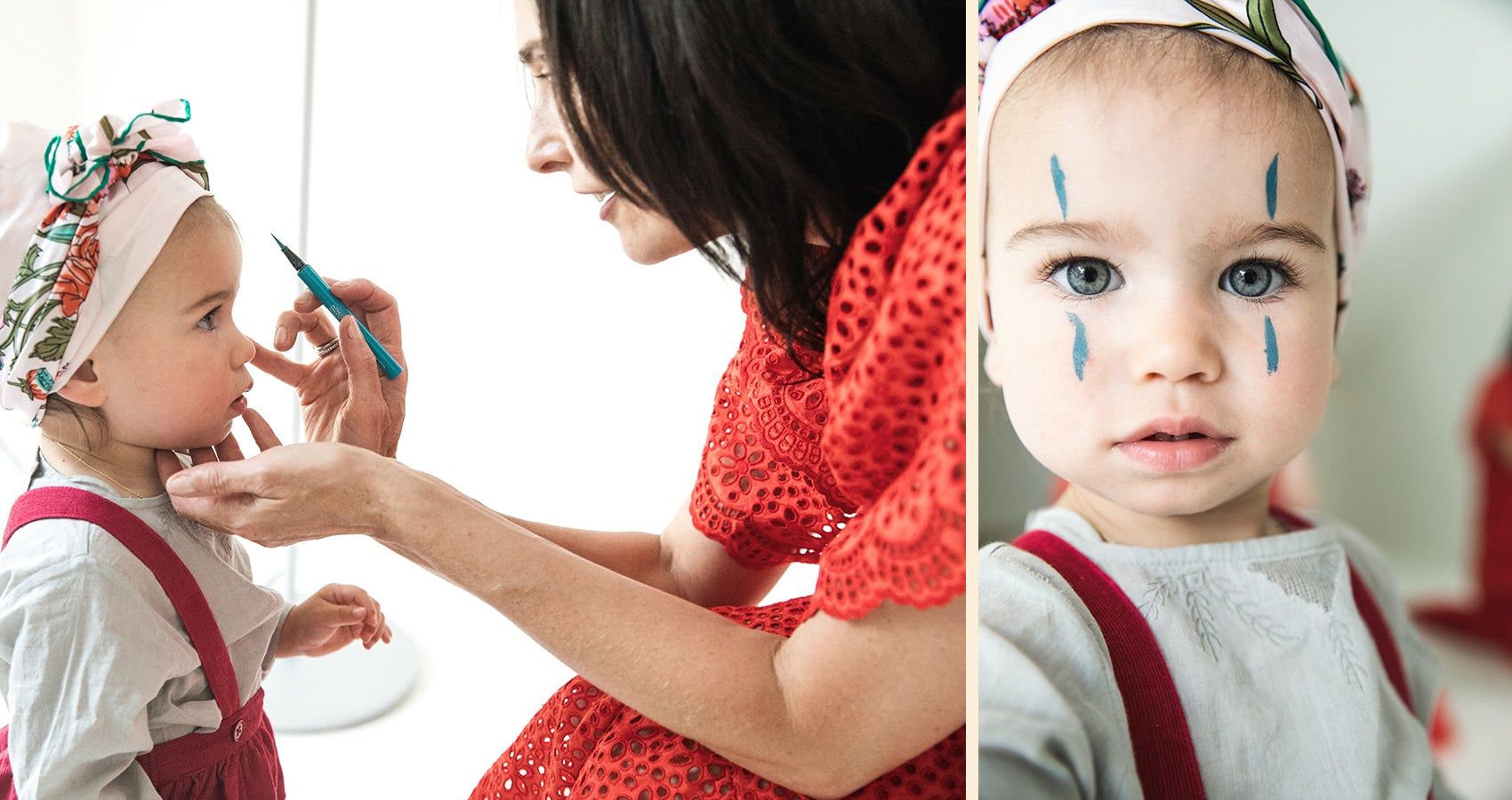
Maisonette Muse
Lia Chavez
Contemplative parenting? Performance artist Lia Chavez makes the case. Here, we talk meditation, art and the expansion of humanity that is motherhood.
- Photography
- Victoria Stevens
- Interview By
- Phoebe de Croisset
As I drive up to the Bellport, N.Y., home that performance artist Lia Chavez shares with her husband, David Shing, and their daughter, Ocean, I assume the modern, all-white interior will feel stark, even cold. For Lia, whose work examines deep consciousness and the phenomenon of light within it, a minimalist space free of distractions is key to the creative process. The front door opens and Lia ushers me in. Her dark hair is pulled back, revealing skin the color, and sheen, of porcelain. A printed silk kaftan floats around her slim figure. I am struck by the warmth and serenity that occupies the house. As Ocean happily plays on her shaggy rug, Lia serves tea, first gingerly adding a fragrant mix of herbs and flowers into a kettle that could totally pass as sculpture, and then carefully pouring the tea into low-rimmed Japanese bowls before turning one twice in her hands and offering it to me.
For Lia, contemplative practice and meditation is not just a part of her life, it’s what informs her life, and her art. If you’re skeptical about what this commitment looks like when you add a child into the mix, I admit I was, too. But after spending the afternoon with Lia, and seeing firsthand what slowing down and being present looks and feels like, I'm this close to booking a one-way ticket to the cave where she spent 30 days meditating in total darkness.
What role does meditation play in your life?
Meditation is the foundation of my life and my art. And I use the word meditation loosely. What I mean by it is to incorporate contemplative practice in your life. As an artist, I am philosophically committed to the integration of life and art, and my artistic practice is very much rooted in the process of things. My goal as an artist is to live in such a way that the art becomes the inevitable outcome of my life. So incorporating contemplative practice into my daily ritual is like breathing, really.
Where, when and how did your meditation practice begin?
Meditation is something has come to me organically over the past few years. But even before that, I was drawn to contemplative practice as a child. I would steal away to the attic to dance in the dark. As a child it was more intuitive, but as an adult, it’s something that I have pursued very consciously.
The intersection of contemplative practice and my artistic process really came to a head in 2012, when I was in the midst of my first performance piece. The 90-day performance had three parts: For the first 30 days I explored prayer, for the second 30 days I explored meditation and for the final 30 days I explored silence. This process took me through a variety of contemplative practices and was my transformation into a performance artist. For the meditation period of the performance, I traveled to Assisi, Italy, and I meditated in the cave of St. Francis, where he spent the latter part of his life practicing this thing called darkness meditation. I spent a month there, living like a monk and exploring that practice of darkness mediation. It utterly changed my life because I encountered the lights — the manifestation of inner light that occurs in the mind’s eye when the eyes are closed and intently focused. And that led to “Luminous Objects,” which was the first piece I created upon discovering light within the meditating mind.
For Lia, contemplative practice and meditation is not just a part of her life, it’s what informs her life, and her art. If you’re skeptical about what this commitment looks like when you add a child into the mix, I admit I was, too. But after spending the afternoon with Lia, and seeing firsthand what slowing down and being present looks and feels like, I'm this close to booking a one-way ticket to the cave where she spent 30 days meditating in total darkness.
What role does meditation play in your life?
Meditation is the foundation of my life and my art. And I use the word meditation loosely. What I mean by it is to incorporate contemplative practice in your life. As an artist, I am philosophically committed to the integration of life and art, and my artistic practice is very much rooted in the process of things. My goal as an artist is to live in such a way that the art becomes the inevitable outcome of my life. So incorporating contemplative practice into my daily ritual is like breathing, really.
Where, when and how did your meditation practice begin?
Meditation is something has come to me organically over the past few years. But even before that, I was drawn to contemplative practice as a child. I would steal away to the attic to dance in the dark. As a child it was more intuitive, but as an adult, it’s something that I have pursued very consciously.
The intersection of contemplative practice and my artistic process really came to a head in 2012, when I was in the midst of my first performance piece. The 90-day performance had three parts: For the first 30 days I explored prayer, for the second 30 days I explored meditation and for the final 30 days I explored silence. This process took me through a variety of contemplative practices and was my transformation into a performance artist. For the meditation period of the performance, I traveled to Assisi, Italy, and I meditated in the cave of St. Francis, where he spent the latter part of his life practicing this thing called darkness meditation. I spent a month there, living like a monk and exploring that practice of darkness mediation. It utterly changed my life because I encountered the lights — the manifestation of inner light that occurs in the mind’s eye when the eyes are closed and intently focused. And that led to “Luminous Objects,” which was the first piece I created upon discovering light within the meditating mind.


And it has really informed much of your work since then.
It led me to understand that there’s this interior cosmos that can be accessed through the practice of withdrawing the senses and meditating, and accessing that became central to my creative process. Throughout that 90-day performance, I was exploring the notion that creative inspiration might occur more readily if body, spirit and mind are aligned. And it did. I found a place where my senses opened up. I was able to hear, see and intuit things that ordinarily were blocked for me. It really showed me that I can utilize certain contemplative practices as a way of training myself, treating my vessel as a living laboratory for creative inspiration and living in such a way where art becomes this natural outcome of my life. And that was really exciting.
It led me to understand that there’s this interior cosmos that can be accessed through the practice of withdrawing the senses and meditating, and accessing that became central to my creative process. Throughout that 90-day performance, I was exploring the notion that creative inspiration might occur more readily if body, spirit and mind are aligned. And it did. I found a place where my senses opened up. I was able to hear, see and intuit things that ordinarily were blocked for me. It really showed me that I can utilize certain contemplative practices as a way of training myself, treating my vessel as a living laboratory for creative inspiration and living in such a way where art becomes this natural outcome of my life. And that was really exciting.
“We are really at a critical point as a society in terms of rethinking and challenging our ideas of how much of our humanity is welcome in the workplace. Motherhood is not a burden; it’s an expansion of our humanity, and that’s actually an asset.”
Marina Abramovic underwent three abortions to avoid becoming a mother, fearing it would be “disastrous” for her work to have to divide her energy between her vocation and motherhood. As an artist and a mother, how do you respond to that?
We are at a really critical point as a society in terms of rethinking and challenging our ideas of how much of our humanity is welcome in the workplace. "Will my creativity be stifled?" "Will I be treated as a sub-citizen?" "Will collectors no longer collect me because they’re afraid I will fall of that map?" These feelings originate from a grossly imbalanced corporate culture that has been determined by masculine values. It has required us to leave a huge percentage of our humanity — and with that, many of our innate capacities — at the door. It gives me goosebumps to talk about because I think we starting to embrace a fuller form of our humanity. It’s not so much about the work as it is realizing our gifts and doing daily work to define what our vocation is, and what that sense of commitment means. We’re exploring the idea that motherhood is not a burden; it’s an expansion of our humanity, and that’s actually an asset.
How has your little girl, Ocean, expanded your creative mind?
My experience has been such a wonderful surprise. And I think part of it has also been ushered in by trusting myself and really saying, "I have done so much in my life, and now I stand at this new frontier. Just because I’m entering into the space of mama-hood, it doesn’t mean I’ll stop being myself." There’s nothing lost! The mentality that you lose so much of yourself — your strength, capacity and capability — is very much a misogynistic trope in culture. There is this incredible increase in one’s capacity when you become a parent, and we need to talk about that, about holistic intelligence and about measuring the qualitative over the quantitative.
We are at a really critical point as a society in terms of rethinking and challenging our ideas of how much of our humanity is welcome in the workplace. "Will my creativity be stifled?" "Will I be treated as a sub-citizen?" "Will collectors no longer collect me because they’re afraid I will fall of that map?" These feelings originate from a grossly imbalanced corporate culture that has been determined by masculine values. It has required us to leave a huge percentage of our humanity — and with that, many of our innate capacities — at the door. It gives me goosebumps to talk about because I think we starting to embrace a fuller form of our humanity. It’s not so much about the work as it is realizing our gifts and doing daily work to define what our vocation is, and what that sense of commitment means. We’re exploring the idea that motherhood is not a burden; it’s an expansion of our humanity, and that’s actually an asset.
How has your little girl, Ocean, expanded your creative mind?
My experience has been such a wonderful surprise. And I think part of it has also been ushered in by trusting myself and really saying, "I have done so much in my life, and now I stand at this new frontier. Just because I’m entering into the space of mama-hood, it doesn’t mean I’ll stop being myself." There’s nothing lost! The mentality that you lose so much of yourself — your strength, capacity and capability — is very much a misogynistic trope in culture. There is this incredible increase in one’s capacity when you become a parent, and we need to talk about that, about holistic intelligence and about measuring the qualitative over the quantitative.
“It’s not all zen all the time. Embrace the chaos. It’s actually a symphony! You have to listen for the harmony in the music. That’s part of the practice!”


You’ve worked so hard on your contemplative practice. Were you nervous about bringing a child into the fold? How does Ocean fit in?
If my contemplative practice has not helped me become a person who can find joy and calm in the chaos of new motherhood, then it’s all for naught! There are those moments — and I think every mother has them — in which you reach your limits and you crack, and then you feel shame and go back, pour love on yourself and tell yourself it’s OK, that it’s the pendulum swinging. You’re learning so much about yourself. Your humanity is expanding — you’re becoming more deeply human, and that’s messy work. But from the very beginning, Ocean has been pure presence. That’s all she knows. Babies don’t have a concept of past or future. Holding a child close to your heart and looking into each other’s eyes is the definition of being present.
What are some of the ways you teach her?
I think there is a very child-centric, commerce-driven culture when it comes to raising children. But it can be so beautiful to integrate your children into your life, as opposed to trying to bend your life around theirs. The big question for us has always been: How do we share our world with Ocean? And we do that in a few ways.
The first is crafting a home that is very calming. It has had a really great impact on all of us, including Ocean. There are very few visual stimuli, as you might have noticed! I am very passionate about natural materials and materiality in general, and when I bring an object in, it usually emanates a kind of beauty and power.
The second is to embrace the chaos. It’s actually a symphony! You have to listen for the harmony in the music. That’s part of the practice! It’s not all zen all the time. You must learn to be very present with the experience of the moment, and that requires surrender, of course.
The third, for us, is not to curtail travel. I really wanted to see how we could do, and so far, Ocean has visited 25 countries. It’s really an exercise in simplicity. I have a small Japanese stroller. I share a suitcase with Ocean. I don’t travel with toys. (The little zipper pouch with the earphones gives Ocean as much joy as anything I could bring.)
And finally, and this sort of goes without saying, but it is critical to have a participatory partner who is egalitarian and very hands-on. Accept help, and do not beat yourself up for it. Accept that you must find balance to be the best version of yourself, and show up as that person.
If my contemplative practice has not helped me become a person who can find joy and calm in the chaos of new motherhood, then it’s all for naught! There are those moments — and I think every mother has them — in which you reach your limits and you crack, and then you feel shame and go back, pour love on yourself and tell yourself it’s OK, that it’s the pendulum swinging. You’re learning so much about yourself. Your humanity is expanding — you’re becoming more deeply human, and that’s messy work. But from the very beginning, Ocean has been pure presence. That’s all she knows. Babies don’t have a concept of past or future. Holding a child close to your heart and looking into each other’s eyes is the definition of being present.
What are some of the ways you teach her?
I think there is a very child-centric, commerce-driven culture when it comes to raising children. But it can be so beautiful to integrate your children into your life, as opposed to trying to bend your life around theirs. The big question for us has always been: How do we share our world with Ocean? And we do that in a few ways.
The first is crafting a home that is very calming. It has had a really great impact on all of us, including Ocean. There are very few visual stimuli, as you might have noticed! I am very passionate about natural materials and materiality in general, and when I bring an object in, it usually emanates a kind of beauty and power.
The second is to embrace the chaos. It’s actually a symphony! You have to listen for the harmony in the music. That’s part of the practice! It’s not all zen all the time. You must learn to be very present with the experience of the moment, and that requires surrender, of course.
The third, for us, is not to curtail travel. I really wanted to see how we could do, and so far, Ocean has visited 25 countries. It’s really an exercise in simplicity. I have a small Japanese stroller. I share a suitcase with Ocean. I don’t travel with toys. (The little zipper pouch with the earphones gives Ocean as much joy as anything I could bring.)
And finally, and this sort of goes without saying, but it is critical to have a participatory partner who is egalitarian and very hands-on. Accept help, and do not beat yourself up for it. Accept that you must find balance to be the best version of yourself, and show up as that person.

